Jun 2017
Smithsonian Channel's America In Color brightens history without blighting it
06/29/17 10:36 AM
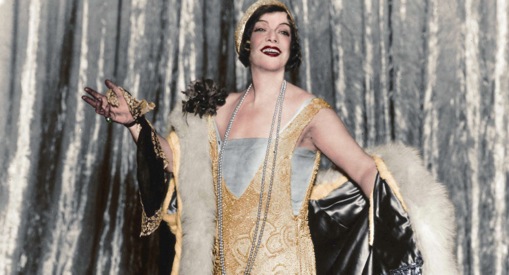
By ED BARK
@unclebarkycom on Twitter
Led by Ted Turner, the colorization of feature films craze peaked in the late 1980s and early 1990s after his company acquired the MGM library and sought to further monetize it.
Critics rightly railed at Turner Entertainment’s finger-painting of film noir classics such as The Maltese Falcon and Casablanca. Their black-and-white presentations were part and parcel of the look and feel of those Humphrey Bogart career-makers. But for the most part, no one cared about the slew of B-movies that Turner also touched up, including the likes of Once Upon a Honeymoon, Poultry Pirates and Smile, Darn Ya, Smile!
Turner also envisioned colorizing the Holy Grail of black-and-white films, Citizen Kane. But he scrapped those plans in 1989 due to technical difficulties and widespread opposition, including director/star Orson Welles’ purported dying wish, “Don’t let Ted Turner deface my movie with his crayons.”
But is colorization an issue when it comes to brightening the looks of vintage TV shows or historical footage? From this perspective, the CBS paint jobs on several I Love Lucy episodes for Christmas season airings made them pop off the screen without hurting anything. The Smithsonian Channel’s five-part America In Color, which lights up the 1920s through the 1960s, is likewise a case of no harm done in terms of desecration or detraction.
Touted as “one of the most ambitious colorizing projects ever undertaken” in publicity materials, America In Color premieres Sunday, July 2nd at 7 p.m. (central) on Smithsonian. And the pair of one-hour episodes made available for review are often a wonder to behold, even if veteran documentary narrator Liev Schreiber drops the words “rare” or “very rare” a bit more often than necessary.
Episode One begins on Sept. 16, 1920 with colorized footage documenting the aftermath of a terrorist attack near New York City’s J. P. Morgan Bank. A horse-drawn wagon with a timer-set detonation device exploded during the lunch hour, killing 38 and seriously wounding 143. The perpetrators, believed to be anarchists, were never apprehended.
After this big jolt of a beginning, America In Color quickly segues to Warren G. Harding’s “Return to Normalcy” presidency without staying too long in any one place. The history of the entire decade is cursory, of course. But the images of those times are greatly enhanced by the mostly impeccable workmanship. This is colorization of a high order, even if the white robes of the then thriving Ku Klux Klan need no further touches.
It’s sickening but also instructive to witness a costumed army of 40,000 Klansmen and women parading down the main streets of Washington, D.C. And even more emotionally devastating to see the only footage that exists of the Greenwood neighborhood of Tulsa, OK after a Klan-led mob burnt it to the ground and left 300 dead. Their crime? They were black and prosperous for those times, with many owning their own businesses.
America In Color also re-presents sports icons Babe Ruth and Jack Dempsey, as well as pathfinding pilot Charles Lindbergh, and to a lesser degree, mobster Al Capone. The ‘20s additionally saw the construction of Manhattan’s famous Empire State Building, mocked as the Empty State Building when the Great Depression hit. By the end of the decade, The Roaring Twenties had ushered in “the greatest boom to bust in history,” says Schreiber.
Episode Two, which whisks through the 1930s, is notable for its colorized looks at Franklin Delano and Eleanor Roosevelt, the decade’s First Family throughout some of the most trying times in American history. Howard Hughes, Amelia Earhart, and gangsters John Dillinger and Machine Gun Kelly also are reborn in living color. As is the Macy’s Thanksgiving Day parade as part of “a nation’s fight for survival -- as you’ve never seen it before.”
Many Americans, and not just the younger ones, are wholly unfamiliar with much of this history. America In Color is by no means the full story. But its overall artistry breathes new life into these two incredibly eventful decades, with three more yet to come. The ‘20s and ‘30s were colorful enough. But there’s no harm done in making them even more vivid.
GRADE: B
Email comments or questions to: unclebarky@verizon.net
Broadchurch returns with an assured grip for what's billed as its final season
06/28/17 08:24 AM
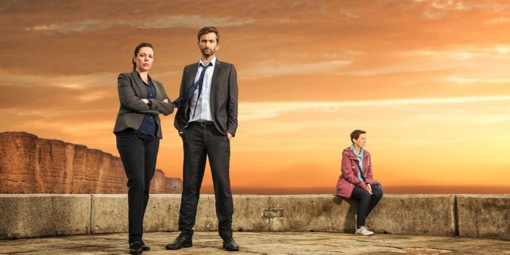
Olivia Coleman, David Tennant team up a last time (supposedly) in Season 3 of Broadchurch. This time they investigate a sexual assault. BBC America photo
Premiering: Wednesday, June 28th at 9 p.m. (central) on BBC America
Starring: David Tennant, Olivia Coleman, Jodie Whittaker, Andy Buchan, Julie Hesmondhalgh, Charlie Higson, Mark Bazeley, Sarah Parish, Arthur Darvill, Georgina Campbell, Lenny Henry, Sebastian Armesto, Carolyn Pickles, Hannah Millward, Charlotte Beaumont, Becky Brunning, Chris Mason, Hannah Rae, Mariah Gale
Produced by: Chris Chibnall, Jane Featherstone
By ED BARK
@unclebarkycom on Twitter
Open-ended endings haven’t yet reached the epidemic stage.
They’re spreading, though. The recent finales of HBO’s The Leftovers and FX’s Season Three of Fargo both left viewers to draw their own conclusions while no one in their right mind expects David Lynch’s ongoing Twin Peaks: The Return to provide any firm grounding after its 18 episode-run on Showtime. This is even more certain after Sunday’s beyond mondo bizarro, yet infuriatingly transfixing hour of whatever that was.
David Chase can be blamed, or credited, for opening this door with his whatever-you’d-like-to-make-of-it denouement of HBO’s The Sopranos. Lost likewise left a lot up to interpretation.
But a first-rate TV series also is capable of knowing how and when to wrap things up with resolution rather than raising more questions. So it’s comforting, in a conventional sense at least, to come away with firm answers after investing in all eight episodes of Broadchurch’s Season 3, which also is billed as its last. It ended two months ago on the United Kingdom’s ITV network and has its Wednesday, June 28th U.S. premiere on BBC America.
David Tennant and Olivia Colman re-team as Detective Inspector Alec Hardy and Detective Sergeant Ellie Miller, this time in pursuit of whoever raped 49-year-old Trish Winterman (Julie Hesmondhalgh) after an alcohol-fueled 50th birthday party for her best friend, Cath Atwood (Sarah Parish).
At the end of their winding investigation, Alec matter-of-factly tells Ellie, “We did our job, Miller. We got the people who are responsible. That’s all we can do.” Bravo.
Tennant’s Alec remains intense, temperamental and steel-eyed while the steadier and outwardly more empathetic Ellie reproaches or twits him when necessary. It remains a great pairing, with both gumshoes also striving in their own ways to discipline and nurture emotionally bruised teenage offspring.
The seaside, tourist-tempting community of Broadchurch was first rocked five years ago by the death of Danny Latimer, son of Beth and Mark Latimer (Jodie Whittaker, Andrew Buchan). The perpetrator turned out to be someone very close to Ellie. But a subsequent trial ended in acquittal and the injustice of it all still rages within Mark much more so than Beth.
Their continued struggles are very much part of Season 3, which also introduces a number of new characters of import. Most of them become suspects in a widening case where seemingly incriminating evidence often isn’t what it seems. But isn’t this always the way?
New to the investigative team is willful young Detective Constable Katie Harford (Georgina Campbell), whose impertinence vexes both Alec and Ellie. Katie also is the daughter of Ed Burnett, manager of a farm shop that employs both Trish and Cath. This turns out to be quite problematic over time. Trish is separated from her husband, Ian (Charlie Higson), while Cath is in a loveless marriage with Jim Atwood (Mark Bazeley), a philandering mechanic.
Two supporting characters from Broadchurch’s first two seasons have less to do, but still do a lot with it. Maggie Radcliffe (Carolyn Pickles), longtime editor of the Broadchurch Echo, clashes with her new, much younger corporate boss, Caroline Hughes (Mariah Gale), who insists on a tabloid approach.
But the newspaper’s straight-ahead, ethical journalism “matters to people,” Maggie protests.
“Then they should be buying it in greater numbers,” Caroline sniffs. She’s instantly easy to loathe.
Young Rev. Paul Coates (Arthur Darvill) likewise is back as the dedicated Anglican vicar who came under some suspicion in Season 1 but now is a would-be bedrock with a declining flock. His scenes with the Latimers are some of Season 3’s strongest.
Tennant and Colman are the marquee players, though. Their consuming dedications to duty, which have repercussions on the domestic front, drive Broadchurch through its thickets of who was where and when and why. Theirs is one of TV’s best-ever detective duos, and they won’t relent until a culprit or culprits are apprehended.
In the end, the only open question (from a crime solving standpoint) is whether this indeed is the finale for Broadchurch. Creator, writer, executive producer Chris Chibnall emphatically says that it is. If that’s really so, Season 3 acquits itself exceedingly well. As do the community’s stately cliffs, which never miss an episode during the course of all those weekly mini-cliffhangers -- and forthcoming answers.
GRADE: A-minus
Email comments or questions to: unclebarky@verizon.net
GLOW gives Netflix a ring of fire
06/22/17 03:04 PM

Premiering; All 10 Season One episode begin streaming Friday, June 23rd on Netflix
Starring: Alison Brie, Betty Gilpin, Marc Maron, Sydelle Noel, Britney Young, Jackie Tohn, Gayle Rankin, Chris Lowell, Britney Young, Britt Baron, Rebekka Johnson, Kate Nash, Sunita Mani, Kia Stevens, Alex Rich
Produced by: Liz Flahive, Carly Mensch, Jenji Kohan, Tara Hermann
By ED BARK
@unclebarkycom on Twitter
Back in the 1980s it was best to put one’s brain in a headlock before succumbing to Gorgeous Ladies of Wrestling on whatever local TV station carried it.
There’s no need for that with Netflix’s GLOW, a serio-comic origins story that has both ample smarts and plentiful thuds (from those on the receiving ends of choreographed body slams).
The 10-episode first season, all of which was made available for review, is available for full-contact streaming on Friday, June 23rd. Binge-watching is aided by episodes that mostly run for 30 minutes or a bit longer rather than weighing in at an hour apiece.
All of the principal characters are affixed with fictional names both in and out of the ring. These include grapplers-in-training Liberty Belle, Zoya the Destroya, Sheila the She-Wolf, The Beatdown Biddies, Fortune Cookie and Welfare Queen in place of “real-life” past GLOW wrestlers such as Brunhilda, Babe the Farmer’s Daughter, Cheyenne Cher, Colonel Ninotchka, The Heavy Metal Sisters, Big Bad Mama, Jailbait and Zelda the Brain.
Glow creator David B. McLane also gets a makeover, emerging as sexploitation film director Sam Sylvia. And although the Netflix saga is primarily a showcase for women, it can be argued that Marc Maron comes close to stealing the show as a sardonic, coke-sniffing taskmaster. Charitably speaking, “he’s more sexist than racist, in my experience,” says the husband of Cherry Bang (Sydelle Noel), who knows Sam from a variety of angles.
The stars of the show otherwise are a severely struggling actress named Ruth Wilder (Alison Brie) and her best friend, Debbie Eagan (Betty Gilpin), a busty blonde beauty who gained a modicum of fame as an off-and-on co-star of the soapy Paradise Cove before motherhood intervened. By the end of Episode One, though, Debbie is at Ruth’s throat after learning of a friendship-shattering trespass. Let’s just say that they eventually are made for each other in the ring as the star-spangled Liberty Belle and her Russian nemesis, Zoya the Destroya.
GLOW builds from the ground up, with Sam holding auditions in hopes of discovering raw talent and “characters” to build on. His young financier, Sebastian “Bash” Howard (Curtis Lowell), is a big believer in crowd-inciting stereotypes such as Welfare Queen, who’s played by a plus-sized African-American woman named Tamee (Kia Stevens). Sam swears by apocalyptic “stories” set in a desolate future in which the women wrestlers fight for the right to couple with one of the planet’s few remaining men. You can guess who wins.
Brie, best known for playing Annie Edison on NBC’s Community, is both vulnerable and laugh-out-loud funny as Ruth. Her send ups of Zoya the Destroya are recurrently comedy gold, with Episode 5’s spur-of-the-moment introduction of the character unexpectedly saving the day and keeping a TV sponsorship by Patio Town in play.
But Ruth also faces some serious personal dilemmas, never more so than in Episode 8.
GLOW also can be unduly cringe-worthy, particularly during a feigned miscarriage sequence in Episode 2 that involves a plastic squeeze bottle of ketchup. It just doesn’t work at all -- on any level.
The ring acrobatics of GLOW are sorely without any “believable” punch until Episode 7, when an unauthorized training session works wonders on the aerial moves of Liberty Belle. Small but thoroughly loutish crowds, even by wrestling standards, eat all of this up a little too easily it seems.
Liz Flahive, whose credits include Nurse Jackie and Homeland, is the driving force behind Netflix’s GLOW as its sole creator and co-executive producer. But the better known Jenji Kohan (Orange Is the New Black, Weeds) is also an influential co-executive producer. And she’s long been about “empowerment” of women, whether they’re behind bars or dealing drugs.
GLOW likewise spotlights women pushing their needs and agendas to the forefront in the face of various male resistors, some of them simpatico to a point. Maron’s Sam Sylvia is the resistor-in-chief, but not to the point of rejecting good ideas that just might pay off.
All of this is bundled into an entertaining, amusing and at times poignant first season that also has some wretched excesses and predictable turns. But there are more than a few little unexpected delights, ranging from Ruth’s impression of Audrey Hepburn winning an Oscar for Roman Holiday to Sam’s learning that a just released real-life movie has upstaged his plans to direct a surefire crowning masterpiece titled Mothers and Lovers.
GLOW then tops itself at the end of Episode 9, when Perry Como’s singsongy “Magic Moments” closes out some decidedly bad behavior by Sam. It’s oh so beautifully discordant.
Assuming there’s a Season Two, Como’s “Round and Round” might be perfectly attuned to GLOW’s principal stomping ground. It includes the lyric, “Find a ring and put it round, round, round. And with ties so strong that two hearts are bound.”
Liberty Belle and Zoya the Destroya just might be able to groove to that.
GRADE: B+
Email comments or questions to: unclebarky@verizon.net
ABC's Gong Show re-do recaptures the Barris essentials
06/20/17 01:31 PM
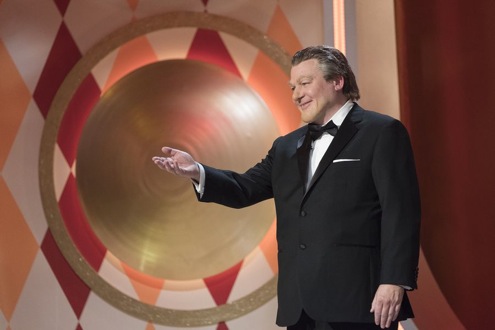
Premiering: Thursday, June 22nd at 9 p.m. (central) on ABC
Hosted by: Tommy Maitland a k a Mike Myers
Produced by: Will Arnett
By ED BARK
@unclebarkycom on Twitter
Welcome all cheeky monkeys, and hairy apes as well, to ABC’s very live-wire remake of The Gong Show.
It instantly has more star power than the network’s upcoming second coming of Battle of the Network Stars, with judges Will Arnett, Zach Galifianakis and Ken Jeong populating Thursday’s one-hour premiere while Mike Myers covers himself in padding and heavy makeup as host “Tommy Maitland.”
Yes, that’s him, even though ABC and executive producer Arnett still aren’t officially copping to anything. Their rather elaborate ruse includes the network’s detailed “biography” of Maitland, who purportedly toiled as an announcer for the British radio show The Whosey Whats before starring in TV’s The Lord Mayor. He also fronted two James Bond “knockoffs’’ -- You Only Live Once, To Be Honest and From Russia, Luv -- and hosted game shows ranging from Tell You What to Dingo’s Got the Baby.
More to the point, one of Myers’ characters on Saturday Night Live, a bathtub-bound British boy named Simon, regularly deployed the tagline “cheeky monkey.” Which is how Maitland begins the show after bounding onstage in a black tux and matching beret.
“All right then, who’s a cheeky monkey?” he immediately asks.
“You are!” the audience exclaims.
“No, you are,” Maitland rejoins. You’ll laugh, you’ll cry, you’ll kiss your brains goodbye -- but happily so, methinks.
A generation and a half have passed since the late Chuck Barris, who died in March at age 87, hosted the original Gong Show from 1976 to 1980. It was a menagerie of mostly horrid or garish acts, with judges putting many of them out of everyone’s misery by striking a plus-sized gong. Those that survived were given scores from 0 to 10, with the eventual high scorer receiving a marginal check (up to $716.32) by the end plus a “Golden Gong” trophy. Gene-Gene the Dancing Machine would occasionally pop in to send Barris and the crowd into a well-practiced frenzy.
The ABC version does not lack for energy or oddities, beginning with The Uni-Piper. He’s a guy in a gorilla suit riding a tricycle and playing flame-spouting bagpipes before his big finish. “I was almost entertained like, too much,” Jeong says.
Maitland provides his own rim shots with a steady beat of one-liners and throwaways.
Arnett, who as executive producer doubles as the show’s boss man, is initially told, “You’re a God that walks as man.” And for the mid-show re-introductions: “You’re like a love puppy and I want to eat you all the way to the stick.”
Less effective is “Well, yank my doodle, that was a dandy.” But who among us can stifle a grin at the pure absurdity of Maitland telling Jeong, “Get this man a cup of tea and a good crop-dusting.” He also shares the trivia that “Galifianakis is Greek for munchies.”
The new Gong Show set is a suitably gaudy mix of reds and oranges, Which proves to be perfect for Married with Bananas (don’t ask) and Uncle Clutch, a fright mask-wearing slayer whose thorough commitment to character is quite hilarious.
Who knows whether enough viewers will buy in to make this a summertime success? ABC initially appeared to have a sure winner with the Alec Baldwin-hosted Match Game. But the ratings have been basically subterranean (perhaps due to the sometimes painfully bawdy content), and its chances for a Season 3 renewal seem iffy.
Some might bail on the new Gong Show while a young woman plays “Mary Had a Little Lamb” on the harmonica with help from a live tarantula named Midas -- who gets popped into her mouth. But then you’d miss out on the impressive rope trickster Buddy Lee and a diva who passionately belts out her operatic love for Arnett.
“I think it resonated with a lot of people in these dark times,” he deadpans.
So yes, I am entertained. Then again, you’re reading the writings of a guy whose alter ego is Uncle Barky, a former child star who later became so desperate for work that he teamed with Maitland in the short-lived Welsh sitcom “Your Fly’s Open But There’s Really Nothing to Hide.”
Enjoy the show!
GRADE: B
Email comments or questions to: unclebarky@verizon.net
Spike TV's The Mist means more money in the bank for horror's King midas
06/20/17 10:37 AM
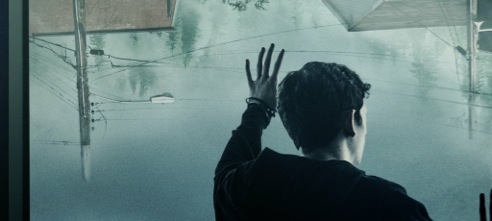
The forecast is foreboding with a 100% chance of death in The Mist. Spike TV photo
Premiering: Thursday, June 22nd at 9 p.m. (central) on Spike TV
Starring: Morgan Spector, Alyssa Sutherland, Gus Birney, Okezie Morro, Danica Curcio, Frances Conroy, Luke Cosgrove, Darren Pettie
Produced by: Christian Torpe, Andrew Wilder, Vlad Wolynetz, Harvey Weinstein, Bob Weinstein, David C. Glasser, Amanda Segal
By ED BARK
@unclebarkycom on Twitter
Perhaps a small community could be terrorized someday by Stephen King’s gigantic piles of cash. I’d pay to see that.
The inveterate horror-meister’s inexhaustible library gets another whirl with Spike TV’s The Mist, adapted from a 1980 novella that also became a 2007 feature film directed by Frank Darabont of The Walking Dead fame.
Spike’s 10-episode version marks the network’s return to scripted series after a 2015 fling with Tut. And based on just the pilot episode (no others were made available for review), it doesn’t look too bad for re-starters. The acting is no great shakes but the special effects and overall atmosphere are overriding plusses.
Otherworldly forces again are at work, this time in the woods near picturesque little Bridgeville, Maine, which was Bridgton in both the novella and the movie. Homeless veteran Bryan Hunt (Okezie Morro), desperate for companionship, awakens to see a friendly German Shepherd named Rufus beside him. But things take a decided turn for the worse when the canine is spooked by something and runs off.
Back on the mainland, high school teacher Eve Copeland (Alyssa Sutherland from Vikings) is stunned to learn she’s been put on administrative leave after parents object to the content of her sex education class. Eve otherwise is super-protective of 16-year-old daughter Alex (Gus Birney), who favors her more pliant dad, Kevin (Morgan Spector). He secretly over-rules his wife and allows Alex to go off to a post-football game party as long as she promises not to drink and is escorted by her openly gay and picked-on friend, Russell Posner (Adrian Garf). This doesn’t go well for anyone.
Meanwhile, the traumatized Bryan staggers his way into town, warns the cops about “somethin’ in the mist” and is jailed for his troubles. Police chief Connor Heisel (Darren Pettie), father of handsome star quarterback Jay Heisel (Luke Cosgrove), doesn’t particularly cotton to either minorities (Bryan) or gays (Russell). But The Mist indeed is coming -- and it’s a great equalizer with its companion mix of lethal, flesh-eating bugs. On a one-to-10 scale of gruesome, this chiller pretty much plays in the same league as Walking Dead.
Also included is accomplished TV vet Frances Conroy (Six Feet Under) as the Copelands’ environmentalist neighbor, Natalie Raven. She and her husband spend much of their time gardening and bike-riding until Bridgeville finds itself suddenly toxic. By the end of the first hour, the entire town is densely fogged and highly perilous. Spike doesn’t mess around.
All of this “re-envisioning” of King’s novella by series creator and Denmark’s own Christian Torpe (Stille Hjerte/Silent Heart) will require numerous swerves and departures from what was originally written 37 years ago. Not that King will or should care. Big-screen versions of his It and The Dark Tower are coming soon in addition to more than a dozen other adaptations currently in the works.
All of which makes The Mist just another moneymaker on a non-stop assembly line. Some are better than others, and this one seems as though it has a chance to make good.
GRADE: B-minus
Email comments or questions to: unclebarky@verizon.net
Megyn Kelly and NBC now know that soiling themselves with Alex Jones was also bad for business
06/19/17 12:01 PM
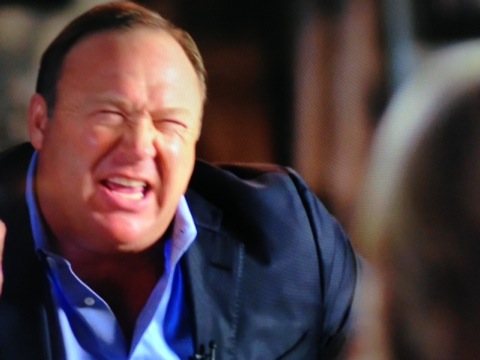
By ED BARK
@unclebarkycom on Twitter
President Trump has yet to deny reports that he called fired former FBI director James Comey “a real nut job” during a notably congenial Oval Office meeting with two Russian officials last month.
A bonafide “real nut job,” hate-mongering Alex Jones, got a big dose of free exposure Sunday night on the third edition of NBC’s Sunday Night with Megyn Kelly. I couldn’t be happier to report that the Peacock’s duplicitous effort to “shine a light” on this lunatic flopped miserably as both a ratings stunt and revenue-producer.
Sensible Americans turned away in droves, as did major advertisers. This left the high-priced Kelly and her still formative show in the clutches of a double whammy.
No. 1, her face-off with Jones bombed in the national Nielsen ratings with 3.71 million viewers in the 6 p.m. hour, trailing ABC’s rerun of America’s Funniest Home Videos (3.71 million); CBS’ 60 Minutes repeat (5.31 million); and Fox’s final full hour of a hardly dynamic U.S. Open (6.09 million), won decisively by the little-known Brooks Koepka.
Worse yet for the Peacock, major advertisers bailed, leaving Megyn Kelly with a mix of gratis Ad Council-stamped public service spots, promos for NBC shows and fire sale rate ads from companies that generally can’t afford this kind of prime-time real estate on a Big Four broadcast network.
The first commercial breaks for Megyn Kelly and NBC’s following American Ninja Warrior are illustrative of what happened Sunday evening. In order of appearance, here are the commercials for her show:
1. PSA for pet adoption (at least it’s a good cause)
2. XYZAL allergy medication
3.. Icy Hot Lidocaine Patch with pitchman Shaquille O’Neal
4. Promo for NBC’s Spartan: Ultimate Team Challenge
5. Promo for NBC’s The Night Shift
6. PSA for Protect Your Everyday
7. Local spot (in Dallas) for Mr. Jim’s Pizza
8. PSA for Ready.Gov/Alerts
9. Promo for NBC’s American Ninja Warrior
In stark contrast, here are the ads during the opening break for American Ninja Warrior:
1. Sprint cellular
2. Degree deodorant
3. Herbal Essence shampoo
4. Zyrtec allergy medication
5. Toyota
6. Neutrogena with pitch woman Kerry Washington
7. IHOP
8. POM Wonderful pomegranate juice (official sponsor of Ninja Warrior)
9. Farmers Insurance
10. Three-in-one promo for NBC’s Hollywood Game Night, The Wall, The Night Shift
It didn’t get any better for NBC and Megyn Kelly after the oily segment with Jones had ended and the show moved on to pieces on home-delivered marijuana, Americans “flocking” to New Zealand and Tom Brokaw’s concluding sermon on the dangers of “hate speech.”
In total, seven public service announcements were used to fill some of the holes left by sponsor defections. NBC also ended up showing 12 separate promos for its upcoming shows.
Should the network have given Jones a forum in the first place, on the grounds that numerous evil-doers have also been grist for nationally televised interviews? From this perspective, Jones’ infowars.com (which repeatedly was referenced), may have millions of supposedly devoted followers. But he remains a crackpot, publicity-seeking fringe player. And his despicable contention that the 2012 Sandy Hook elementary school massacre is all a hoax at this point should be given exactly the national media attention it deserves -- which is none.
Jones also has made a series of other moronic claims, some of which he’s later retracted under threats of lawsuits. His sources appear to be a coterie of young male staffers who concoct theories for him to spurt on his show.
Before she sat down with Jones, Kelly made a point of telling viewers that he “has the ear of the President,” who indeed did an interview on infowars.com back in December 2015, mainly to promote his new book and a book-signing. But does he in reality have any genuine influence over the President? Even Jones disputes that.
NBC aired the Jones interview on Father’s Day after reportedly “toughening up” the segment and including comments from the father of a Sandy Hook victim and conservative MSNBC contributor Charlie Sykes, who said that Jones represents a “toxic paranoia.” Gee, thanks for the heads-up. Would never have known that.
Jones’ website now of course is making the most of his national prime-time exposure and its ripple effect. One of its “stories” is headlined, “Media Celebrates Megyn Kelly’s Dishonest Hit Piece on Alex Jones.”
NBC News should be deliberating why and how this guy was given the opportunity to soil its air in the first place. And nothing causes a network to become more reflective than lousy ratings and a big advertiser defection. Ask Bill O’Reilly.
NBC and Kelly would have been far better served by junking Jones and pulling together a quick interview with the newly contrite Ted Nugent, who in fact accomplished things in life as a hit-making rock musician before devolving into a -- real nut job. Chastened after last week’s Republican baseball practice shootings, the man who once encouraged President Obama to “suck my machine gun” now says that people of all political beliefs “have got to be civil to each other. I’m not going to engage in that kind of hateful rhetoric anymore.”
This is a far cry from the unrepentant Jones, who from this point on should be left to wither and fade away by his own hand. If there’s any silver lining here, it’s that his NBC interview turned out to be a bad business decision -- for the network at least. In that respect, justice is served.
Email comments or questions to: unclebarky@verizon.net
Acorn TV's Loch Ness trades in above-ground monstrosities
06/15/17 01:26 PM
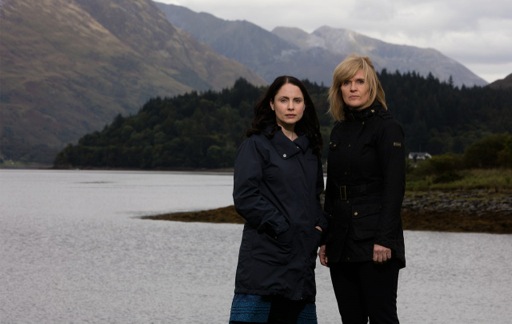
Laura Fraser and Siobhan Finneran are puzzler solvers in Loch Ness. Acorn TV photo
Premiering: Begins streaming weekly Monday, June 19th on Acorn TV
Starring: Laura Fraser, Siobhan Finneran Alastair Mackenzie, Shona McHugh, Jack Bannon, John Sessions, John Heffernan, Don Gilet, Gray O’Brien
Produced by: Ross McKenzie, Tim Haines, Natalie Usher
By ED BARK
@unclebarkycom on Twitter
It launched earlier this month as The Loch on the United Kingdom’s ITV network.
Oh, but that’s just too drab for American audiences. So how about a little extra marketing punch? Acorn TV, steadily gaining momentum as a streamer of all things British, gives it the old monster mesh with Loch Ness. And the serial murder mystery indeed is serpentine, even without any extra added sightings of Scotland’s fabled “Nessie.”
The six-episode entanglement begins unwinding weekly on Monday, June 19th, with the entire miniseries made available to TV critics for review. Some giant leaps are taken en route to the climactic unveiling of the killer. But you’re unlikely to say, “Aha, I knew it!” Because Loch Ness is anything but a telegraphed punch after the hook is set in Episode 1’s opening credits. Hmm, who is that dead man anchored in the same down-below where a tourist-enticing monster supposedly also lurks? You’ll know in due time, but first there are other corpses to dissect.
“You have a cold-blooded predator in your town,” deduces DCI Lauren Quigley (Siobhan Finneran), who’s all business after blowing in from Glasgow to take command from Lochnafoy’s finest. Her principal assistant is local detective Annie Redford (Laura Fraser), whose husband, Alan (Gray O’Brien), makes his living as a Nessie-spouting tour boat owner. Their 18-year-old daughter, Evie (Shona McHugh), constantly grates on her mom -- and vice-versa. But might this rebellious teen know more than she lets on? Well, of course she does.
Loch Ness sorts through this chamber of horrors (and chamber of commerce nightmare) in ways that can be both gripping and more than a little far-fetched at times. Suspects abound and confound. The overall detective work remains competent enough, although in one case the companion editing is rather amazingly sloppy. It’ll be hard to miss in Episode 3, when Annie brings in the suspicious Dr. Simon Marr (John Heffernan) for questioning.
He ends up stalking out of the cop shop after telling her, “Your manner is really hostile and aggressive.”
Within just a few seconds, Annie and Lauren are shown reviewing the videotape. Marr’s retort is magically edited to, “Your manner is hostile and aggressive.” A small point, perhaps, but still attention-getting because the two scenes are played so very closely together.
Also in the law enforcement mix is visiting forensic psychologist Blake Albrighton (Don Gilet), a headstrong naysayer who apparently once had a thing with Lauren, even though it’s not really fleshed out. The prototypically gruff, elderly chief inspector is Frank Smilie (John Sessions), who wants Blake off the case after a clash over proper procedure.
There are elements of ITV’s acclaimed Broadchurch, which is returning for a final go-around later this month (June 28th) on BBC America. But that series’ ad hoc detective duo of haunted Alec Hardy (David Tennant) and plucky Ellie Miller (Olivia Colman) far surpasses the crime teams of Loch Ness. The strongest performance is by Finneran, whose terse jabs and counter-punches are well-delivered throughout.
Be assured that answers will be forthcoming before Loch Ness comes to a halt. Still, there are several too many side trips and attendant altercations before the big reveals. I did watch it all, though, eyes rolling at times. And the vistas remain distinctive and eye-catching even when the story loses focus.
GRADE: B-minus
Email comments or questions to: unclebarky@verizon.net
Hoping to nail it with TNT's Claws
06/07/17 02:20 PM

Premiering: Sunday, June 9th at 8 p.m. (central) on TNT
Starring: Niecy Nash, Jenn Lyon, Carrie Preston, Karrueche Tran, Judy Reyes, Dean Norris, Jack Keys, Kevin Rankin, Jason Antoon, Christina Moore, Dale Dickey
Produced by: Rashida Jones, Will McCormack, Janine Sherman Barrois, Eliot Laurence
By ED BARK
@unclebarkycom on Twitter
TNT’s headlong pursuit of cable territory already claimed by FX and AMC gets another push in the right/wrong direction with Claws.
Seamy, steamy and at times a prototypically hot mess, the new hour-long series is touted in TNT publicity materials as “a midnight-dark, wickedly funny meditation on female badness set in a Central Florida nail salon.”
Although they’re basically at the mercy of diabolical men, the girl power is upfront throughout. That also goes for the plus-sized cleavage on constant display by star Niecy Nash and her principal bosom buddy, Jennifer (Jenn Lyon). Their common ground is the Nail Artisan salon, located in a poor-end-of-town shopping strip called Palmetto Plaza.
But Desna (Nash) has big plans to move on up to prime property in Sarasota after enduring a nail-bitting year of laundering money for a lucrative “Dixie Mafia” drug clinic run by “Uncle Daddy” (Dean Norris from Breaking Bad and Under the Dome). You know how this can go, though. Once you’re in, the double-dealing begins. And nefarious Uncle Daddy and his oldest crum bum son, Roller (Jack Keys), aren’t about to let a good thing escape their clutches.
The principal males in the Claws cast are vicious, inept, or in the case of Desna’s live-in brother, Dean (Harold Perrineau from Lost), very mentally ill.
“There’s nothing in this world quite as useless as a useless man,” Desna proclaims early in Episode One, one of three made available for review in a 10-episode first season. The series’ principal executive producer is Rashida Jones (Parks and Recreation), who also stars in sister station TBS’ Angie Tribeca.
For some reason, take-charge Desna continues to date and mate with Roller, a bad-nasty knuckle dragger who makes dog poop on a shoe sole seem rarefied. Their bang-bang sex scenes stretch the outer limits of advertiser-supported basic cable, as does the language in Claws’ opening hour. Things get somewhat tamer in the next two episodes, but the content remains notably adult -- and recurrently juvenile.
In Episode 3, for instance, this is the kind of show that tries to make a comedy segment out of a foaming-at-the-mouth epileptic seizure at the clinic. This later turns out to be not all that it seemed. But the insensitivity involved is still staggering -- even more so if you know someone who suffers from epilepsy.
The other members of Desna’s nail salon crew are Polly (Carrie Preston), who’s just out of jail, and “Quiet Ann” (Judy Reyes), who’s demonstrably gay. Against her will -- and in the interests of a cover-up, Desna also takes on the younger, self-centered and basically brainless Virginia (Karrueche Tran). Her cover story, which unfolds at the start of Episode 3, is both cray-cray and fairly amusing.
Norris, now getting parts that Michael Chiklis might have landed a few years back, throws himself headlong into the role of Uncle Daddy, who also presides over a strip club. It’s a scenery-inhaling turn, particularly at first sight in Episode One. After the considerable glory of Breaking Bad, here’s a bald, middle-aged, heavy set character actor who’s cashing in while he can. His frenetic approach to Uncle Daddy could use a sedative, but it certainly doesn’t go unnoticed. “They took muh baby boy,” he sobs in Episode Two before exchanging socks to the jaw with his very haggard wife, Juanda (Dale Dickey).
Nash gets her first-top-of-the marquee TV role as Desna, and goes for it with gusto as Claws’ leading lady. Brassy and bossy, she also tries a little tenderness on occasion. And her nails indeed are something to behold.
Preston is solid in the role of the drawling, sweet-tempered Polly while Lyon’s Jennifer nicely juggles her roles as both the salon’s second-in-command and the wife of Big Daddy’s underfoot younger son, Bryce (Kevin Rankin).
Claws never lacks for energy, and its premise and cast composition are somewhat novel. But what it too often lacks is dexterity and texture. It’s easy enough to roll with, and gets a little easier as the story takes shape and then provides a pair of non-telegraphed twists at the close of Episode 3. But the line between pulling it all together or having it all fall apart seems squiggly at best.
GRADE: C+
Email comments or questions to: unclebarky@verizon.net
Living the life of tortured standups in Showtime's searing I'm Dying Up Here
06/02/17 12:34 PM
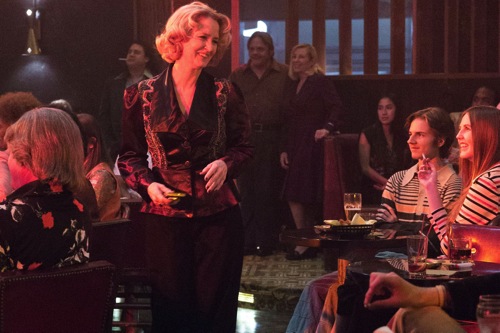
Melissa Leo is rarely all smiles as owner of Goldie’s comedy club. Showtime photo
Premiering: Sunday, June 4th at 9 p.m. (central) on Showtime
Starring: Melissa Leo, Ari Graynor, Andrew Santino, Michael Angarano, Clark Duke, Erik Griffin, RJ Cyler, Al Madrigal, Jake Lacy
Produced by: Jim Carrey, Dave Flebotte, Michael Aguilar, Christina Wayne, Cindy Chupack, Dave Holstein
By ED BARK
@unclebarkycom on Twitter
It’s oftentimes said, usually by its practitioners, that comedy isn’t pretty.
Showtime’s I’m Dying Up Here, set in Los Angeles, circa 1973, is nothing if not a firm believer. It unsparingly puts standup comics in a self-inflicted torture chamber before further turning the screws. And heaven help them, they like it.
The principal soul-sucker/tough lover -- but also the best thing that ever happened to many startup standups -- is Melissa Leo’s Goldie Herschlag, who’s obviously modeled after Mitzi Shore. Her same-named comedy club is the Sunset Strip’s undisputed “only runway to Carson,” meaning Johnny’s Tonight Show.
Goldie -- and only Goldie -- will tell her unpaid underlings when they’re “ready” while also bouncing them from the nightly lineup on a moment’s notice for someone she deems readier. It’s a fire-breathing, suitably showy role for the multi-awarded Leo, who rasps, chain-smokes and boozes her way toward a certain Emmy nomination. “Oh, there’s a pecking order,” Goldie tells anyone who dares question her power or motives. “Goes me, you.”
Showtime made six of Season One’s 10 episodes available for review. Like a comic in search of just the right “set,” they stumble on occasion. But I’m Dying Up Here delivers far more than it flails. It’s uniquely tragic, tragi-comic and riotously funny in some instances. Those who might initially be put off are advised to give this mix of basically maladjusted dreamers a chance to hit their marks.
Jim Carrey, a principal executive producer, is one of the comics who got his start at Mitzi Shore’s The Comedy Club, as did the likes of Richard Pryor (played very deftly by guest star Brandon Ford Green in Episode 3), David Letterman, Robin Williams, Freddie Prinze, Jay Leno and Sam Kinison.
Carrey also has recounted, in interviews and Showtime publicity materials, how he lived in an acquaintance’s L.A. closet for a year while trying to make his bones as a comic. I’m Dying Up Here doubles this particular pleasure by putting two transplanted Boston comics, Eddie Zeidel and Ron Shack (Michael Angarano, Clark Duke), in this severely cramped situation. They’ve come to L.A. expecting to crash with a comedian who’s become an overnight big deal by “getting the couch” on Carson’s career-making late-nighter. But that accommodation never materializes, thanks to the self-destructive comedic gene.
There’s also a cynical, striving, ever-inappropriate comic named Bill Hobbs (Andrew Santino), who at least has a degree of self-awareness. “I’m an anti-social asshole, a narcissistic douche bag,” he admits. That he is, with the slightly saving grace of having a disagreeable, demeaning father who looms large in later episodes.
The series’ most likable character, attractive Cassie Feder (Ari Graynor), is a drawler from Wink, Texas whose parents died in a car wreck when she was 10. She makes this part of her act in a determination to break out of the Phyllis Diller/Joan Rivers/Totie Fields mold of female comedians whose routines are built around being “unattractive” to men. But Goldie doesn’t much like that style, meaning Cassie repeatedly gets bumped or relegated to lousy, late hours weekday slots. It’s the boss lady’s way of nurturing.
The roll call of tortured souls also includes:
***Comedy club/emcee performer Ralph King (Erik Griffin), a Vietnam War veteran who’s repressed some of his worst memories -- or thinks he has.
***Sully Patterson (Stephen Guarino), struggling to make ends meet as the husband of a supportive wife and father of their new baby.
***Edgar Martinez (Al Madrigal), a mockup of Freddie Prinze with a fairly polished routine but no tact whatsoever.
***Adam Proteau (RJ Cyler), a very green African-American comic who takes a series of degrading jobs to survive.
***Nick Beverly (Jake Lacy), introduced in later episodes as an off-and-on drug addict who rather suddenly lands The Tonight Show. But will he stick the landing?
In the first six episodes, the only real-life characters are Pryor and Carson, played by Dylan Baker in a manner that manages to avoid caricature, but sometimes not by a lot. His Johnny mostly emits the big, boisterous Carson laugh, but does have an angry backstage moment in Episode 6.
Meanwhile, the random misadventures of Eddie and Ron range from an appearance on Let’s Make A Deal to taking a “hot wings” challenge in hopes of offsetting the unseen expenses of taking two women to dinner.
I’m Dying Up Here intends to tell the tale of a time when cutting edge comedians with “a voice” were starting to flourish and multiply while old-timers became embarrassments -- albeit rich ones. Cassie is the principal female instrument, balking at Goldie’s insistence that she do “more women appropriate” humor and regularly getting benched as a result. But this also is the year when Billie Jean King defeated the chauvinistic Bobby Riggs in their celebrated “Battle of the Sexes,” even though she had to endure this televised moment with the real-life Frank Gifford, who asked, “The feminist ‘thing,’ how important is that, Billie?”
Leo’s Goldie isn’t entirely without virtue, although neither is a tarantula perhaps. Her dirtiest deed so far comes in Episode 4, when Goldie’s ex-husband (guest star Jere Burns), now a weathered comedian, looks to prep for a possible national TV spot. What she does to him is unspeakable -- if you’re a comedian.
Things are laid on too thick at times, and some storylines take predictable turns. Even so, I’m Dying Up Here convincingly recreates both a period and the primal scream existence of would-be star comedians who seem to most enjoy trading very barbed insults during frequent gatherings at a local diner.
One insult isn’t all that funny. And it doesn’t come from a comic. Guest star Robert Forster, cast in Episode One as a tightly wound, formally dressed grieving father, renders even this bunch silent when he finally bursts. “You’re children with your eyes closed, thinking nobody can see you,” he bellows. “I see you! I see through all of you!”
Mike drop.
GRADE: A-minus
Email comments or questions to: unclebarky@verizon.net
